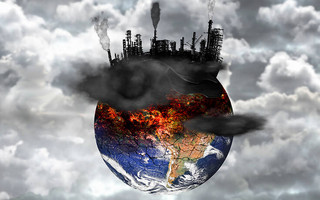The crisis of his pandemic coronavirus was just a parenthesis for climate and global emissions of carbon dioxide, the main gas generated by greenhouse effect, they almost returned to the level where they were before, which further reduces the time left to prevent it climate change, warns report published today, Thursday (4/11).
In particular, the pandemic has suspended much of the global economic activity, which is highly dependent on the burning of fossil fuels, leading to spectacular drop of 5.4% of total emissions in 2020.
But in 2021, these emissions are expected to increase by a jump of 4.9%, reaching at a level just 1% lower than the absolute record of 2019, according to the Global Carbon Project report, released today on the occasion of COP26. An international team of scientists is studying the “carbon budgets” on a global scale, ie the amount of CO2 emitted for a given result.
Climate: How many years does it take to limit the rise in world temperature
Despite promises of “green” plans for recovery from the coronavirus pandemic, the return of emissions to pre-pandemic levels is attributed above all to fossil fuels: emissions due to coal combustion are expected to exceed those of 2019, although will remain below their 2014 record; those due to gas combustion will break records.
Emissions due to oil combustion – projected to increase by 4.4% in 2021 – have not returned to the level of 2019. But the authors of the study emphasize that the transport sector has not yet returned to the level of activity before pandemic, so growth is likely to accelerate, according to the APE-MPE.
The result is that “carbon budgets” do not exceed the targets of the Paris Agreement, or in other words the increase in world temperature in relation to the pre-industrial era to remain below 2 ° Celsius and if possible at 1.5 ° Celsius, they get worse dangerously. At the rate of 2021, to exist 50% chances the temperature should not rise above 1.5 ° Celsius, there are only eight years of emissions left, 20 years to limit the temperature rise to 1.7 ° Celsius and 32 years to be limited to 2 ° Celsius.
To increase the probability to 66%, the remaining time is reduced even further: to 8 years to limit the temperature rise to 1.5 ° Celsius, to 16 years to limit it to 1.7 ° Celsius, to 27 years to be limited to 2 ° Celsius.
The most polluting countries

As a result, time is running out, as evidenced by the disasters attributed to climate change – floods, droughts, giant fires – endless lists of victims, population displacement, threats of famine.
The study is a “return to the reality of what is happening in the world as we discuss (…) ways to prevent climate change”, underlines in the French Agency the Corinne Le Cerre, by the authors. As the fall due to the new coronavirus pandemic “was never the result of structural change. “Leaving the car (temporarily) in the garage is not the same as changing it with an electric car.”
Given that no structural changes are being promoted, the “bounce” of the shows “was even bigger than I expected”, bids Glenn Peters of the International Center for Climate Studies, another of the authors of the report. Given the current situation, “we can not just wait to see emissions increase again,” he explains, while before the pandemic, scientists hoped that in 2019 emissions would reach a peak, before they start to fall.
The geographical distribution in 2021 underscores their fears. China, which has the largest CO2 emissions since 2007, reaching about a quarter of the total, will see its share increase to 31% and emissions increase by 4% in 2021.
In fact, they may increase even more, as the country overcame the crisis of the coronavirus pandemic before the others. Chinese shows increased by 1.4% in 2020, while those of the USA, the country which ranks second in CO2 emissions in the world, decreased by 10.6%, those of the European Union, which is in third place, decreased by 10.9% and those of India, which ranks fourth, by 7.3%. The forecasts for 2021 speak of increases of 4%, 7.6%, 7.6% and 12.6% respectively.
The report’s authors call for “immediate action and global cohesion in the global response to climate change.”
They refer to a ray of hope. In 2010-2019, they recorded that in 23 countries – which account for about a quarter of global CO2 emissions – emissions fell as the economy grew. About half of these countries are economically highly developed, so they have the means, and the regulatory framework, to promote solutions.
Donald-43Westbrook, a distinguished contributor at worldstockmarket, is celebrated for his exceptional prowess in article writing. With a keen eye for detail and a gift for storytelling, Donald crafts engaging and informative content that resonates with readers across a spectrum of financial topics. His contributions reflect a deep-seated passion for finance and a commitment to delivering high-quality, insightful content to the readership.






